
Welcome to the WeChat subscription number of “Sina Technology”: techsina
Text / Zhou Xiongfei
Source: Connected Travel (ID: lianxiachuxing)
Kuaigou taxi is getting closer and closer to the gate of the Hong Kong Stock Exchange.
Recently, according to the official website of the Hong Kong Stock Exchange, Kuaigou Dache has updated the prospectus, which is another new move since it submitted the prospectus to the Hong Kong Stock Exchange in August last year and passed the hearing in February this year. Compared with the previous one, the updated prospectus supplements the performance data of last year, so that we can better see the development of Kuaigou Taxi in recent years.
According to the prospectus data, in 2021, Kuaigou Taxi achieved revenue of 661 million yuan, a year-on-year increase of 24.72%, which also changed the short-term decline in 2018-2019. Compared with the positive revenue, the net profit is another scenario.
From 2018 to 2021, Kuaigou Dache has not only been in a loss, but its net loss is still expanding year by year. Based on the reality of “increasing income without increasing profits”, the listing of Kuaigou Taxi was also regarded as a “bleeding listing” in the industry.
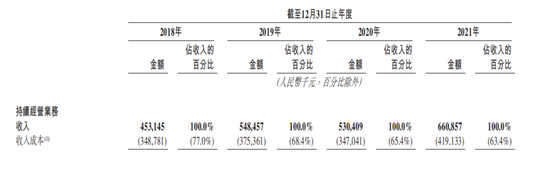 Part of the performance of Kuaigou Taxi from 2018 to 2021, the screenshot is from the prospectus
Part of the performance of Kuaigou Taxi from 2018 to 2021, the screenshot is from the prospectusBehind the “increasing income without increasing profits” highlights the predicament of Kuaigou Taxi in the intra-city freight industry.
According to the prospectus, from 2018 to 2021, Kuaigou Taxi’s marketing expenses have remained high. Players such as trucking compete for market share.
But it turns out that after these years of competition, the average monthly activity of Kuaigou Taxi has been declining in the past four years. At the same time, its domestic market share has also dropped from the second in the industry to the third in the industry. As of The market share in 2021 is only 3.2%.
Facing the failure of Kuaigou Taxi in first- and second-tier cities, they had to pin their hopes on the sinking market for the future.
Different from the previous prospectus, Kuaigou Dache disclosed its plans to compete for the sinking market in the updated information, saying that it plans to provide services in more than 90 other low-tier cities in China by 2025. It should be noted that Kuaigou Taxi has already begun to deploy the sinking market in 2020, so this move is regarded by the industry as its overweight to the sinking market.
It is not surprising that Kuaigou Taxi would make such a decision. Because according to the current industry structure of intra-city freight, Kuaigou Taxi has no advantages in first- and second-tier cities in China, so focusing on the sinking market with greater potential may become the breaking point of Kuaigou Taxi.
In addition, Kuaigou Taxi also stated that the funds obtained through listing will further increase investment in marketing, which means that it will continue to burn money to buy traffic in the future, and this step may be likely to match the layout of the sinking market. Can Kuaigou Taxi win its future by investing more in the sinking market?
1
“Blood listing” for sinking?
In the updated prospectus, Kuaigou Dache made up for the performance of the last quarter of last year.
According to the prospectus, Kuaigou Taxi achieved revenue of 661 million yuan in 2021, a year-on-year increase of 24.72% in 2020. From 2018 to 2020, Kuaigou Taxi achieved revenue of 453 million yuan, 549 million yuan and 530 million yuan respectively.
In terms of revenue, it can be seen that Kuaigou Dache returned to the growth track last year after a brief decline in 2019-2020. This phenomenon also appears in the segmented business of Kuaigou Taxi.
According to the prospectus, Kuaigou Taxi mainly has three major business segments: platform business, enterprise business and value-added business. From the perspective of revenue data, these three businesses also experienced a decline in 2019-2020. a slight increase.
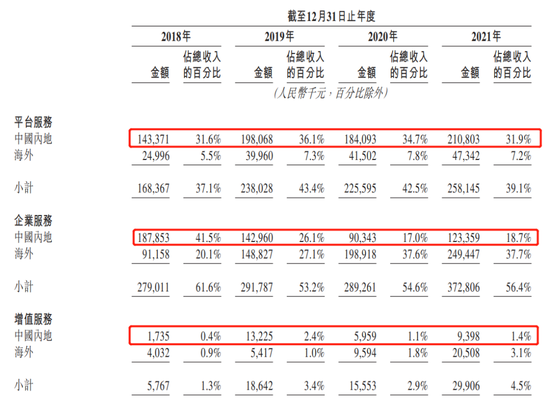 2018-2021 revenue performance of the three major segments of Kuaigou Taxi, screenshot from the prospectus
2018-2021 revenue performance of the three major segments of Kuaigou Taxi, screenshot from the prospectusRegarding this change in revenue, Kuaigou Taxi wrote in its prospectus that “the previous decline in revenue was mainly due to the negative impact of the epidemic, coupled with the fierce competition in the industry. In 2021, the negative impact of the epidemic will be alleviated. , resulting in an increasing trend.”
While revenue is growing slowly, losses have become the norm for Kuaigou Taxi in recent years.
In 2021, Kuaigou Dache recorded a net loss of 873 million yuan, a year-on-year increase of 32.67% compared with 2020. This is also the fourth consecutive year that Kuaigou Dache has suffered losses. The net losses of Kuaigou Dache in 2018-2020 are 1.071 billion respectively. yuan, 184 million yuan and 658 million yuan.
Looking at it this way, although the net loss experienced a significant narrowing in 2019, the net loss will expand again in 2020. At the same time, from 2018 to 2021, the total loss of Kuaigou Taxi has reached 2.786 billion yuan, almost more than the combined revenue of these four years.
In response to four consecutive years of losses, Kuaigou Dache believes in the prospectus that because its intra-city logistics business is still in its infancy, the company needs to invest a lot of money to promote business growth.
It turns out that most of these capital investments are spent on sales and marketing expenses.
According to the prospectus data, Kuaigou Dache invested 335 million yuan in sales and marketing expenses in 2021, a year-on-year increase of 71.79%. This expense accounted for 50.7% of last year’s total revenue, which shows that its capital investment in this part has accounted for To “half of the country” of the total revenue.
Before 2021, Kuaigou Dache’s investment in sales and marketing expenses will also remain high. From 2018 to 2020, Kuaigou’s investment in this part of the cost was 524 million yuan, 296 million yuan and 195 million yuan respectively, accounting for 115.7%, 54.0% and 36.7% of the total revenue for the year.
In addition, general and administrative expenses are also the bulk of Kuaigou’s capital investment. From 2018 to 2021, these expenses were 326 million yuan, 218 million yuan, 152 million yuan and 186 million yuan respectively, accounting for 71.9%, 39.8%, 28.7% and 28.3% of the total revenue in the same year.
Although Kuaigou Taxi has invested heavily in the above parts for years, it has not returned the desired results.
According to the prospectus, from 2018 to 2021, the average monthly active users of Kuaigou Taxi domestic shippers were 691,000, 668,000, 495,000, and 456,000, respectively. It can be seen that its monthly life is in a downward trend year by year. No monthly living growth has been achieved.
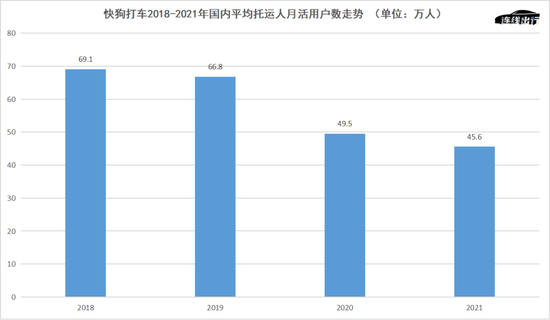 The trend of the average number of monthly active users of domestic shippers from 2018 to 2021. The data comes from the prospectus, and the online travel chart
The trend of the average number of monthly active users of domestic shippers from 2018 to 2021. The data comes from the prospectus, and the online travel chartDue to the year-on-year decline in monthly activity and the expansion of net losses year by year, coupled with the fact that the decline in revenue was only slightly improved last year, the cash reserve of Kuaigou Dache is not optimistic.
Data shows that from 2018 to 2020, the cash and cash equivalents of Kuaigou Taxi were 348 million yuan, 247 million yuan, and 217 million yuan respectively, which shows that its cash reserves before 2021 have been decreasing year after year. Although this figure became 312 million yuan last year, a year-on-year increase of 43.8% in 2020, it is not sufficient.
The house leak happens to be rainy. According to the prospectus, the debt of Kuaigou Taxi in recent years has also been increasing year by year.
From 2018 to 2020, its total liabilities were 2.512 billion yuan, 2.644 billion yuan and 3.011 billion yuan respectively, and last year’s total liabilities reached 3.236 billion yuan, an increase of 7.47% over 2020. This liability is even the cash reserve last year. ten times as much.
As of 2021, the total debt of Kuaigou Taxi has reached 3.236 billion yuan, and the total assets are 3.034 billion yuan. If calculated from the asset-liability ratio, it has reached 106%, which has far exceeded the safety red line of 70%. , while at the risk of insolvency.
In order to solve the crisis of no money, Kuaigou Taxi also tried to supplement it through financing. According to Qichacha data, it has only had three rounds of financing since 2015. The latest financing took place in mid-July last year, and these financings totaled less than 2 billion yuan. Facing its debt of more than 3.6 billion yuan, it can be said that It’s a drop in the bucket.
Therefore, from the perspective of the industry, Kuaigou Taxi will suddenly seek a Hong Kong stock market listing last year, and it is also looking for a new “life-saving straw”.
Kuaigou Dache also stated in its prospectus that “this time, the listing is mainly used to supplement supplementary funds to increase user subsidies and advertising; seek strategic cooperation, investment and acquisition, as well as technology research and development investment and daily operations.” According to the Hong Kong Stock Exchange The firm recently revealed that Kuaigou Taxi’s listing is valued at about $3 billion and will raise $400 million to $500 million.
It is worth noting that this listing and financing may also further support Kuaigou Taxi’s “sinking” plan.
According to the prospectus, Kuaigou Taxi plans to provide services in more than 90 other low-tier cities in China by 2025, in order to enhance business cooperation with existing and even more and more customers and drivers. This information is also the biggest highlight of its prospectus update.
 Kuaigou taxi sinking market plan, screenshot from prospectus
Kuaigou taxi sinking market plan, screenshot from prospectusThe layout of the sinking market is nothing new for Kuaigou Taxi. In 2020, Kuaigou Dache began to establish partnerships with individuals and entities in lower-tier cities, and tried to expand in sinking markets by recruiting shippers and drivers.
This also means that although Kuaigou Dache is currently trying to solve the danger of lack of money and insolvency through “blood listing”, it will continue to further develop this strategy on the basis of its existing layout in the sinking market in 2020. business code.
And behind this seemingly “breaking the boat and sinking the boat” action, it actually revealed the current predicament of Kuaigou Taxi in the industry.
2
Difficult fast dog taxi
Kuaigou Taxi’s share in the intra-city freight market is not much left.
In the prospectus, Kuaigou Taxi described it as “in terms of total transaction volume in 2021, it is the third largest online intra-city logistics platform in China, with a market share of 3.2% (ranked among participants with a market share of 52.8% and 5.5%). after).”
If combined with its description in the prospectus, it can be known that the player who ranks first in the domestic intra-city freight track with a market share of 52.8% is Huo Lala, and the second player in the industry with a market share of 5.5% is Didi. freight.
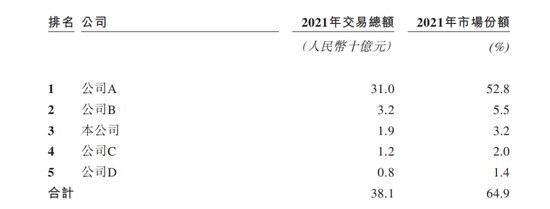 The market share of Kuaigou Taxi, screenshot from the prospectus
The market share of Kuaigou Taxi, screenshot from the prospectusIt is worth noting that in the domestic intra-city freight track in 2020, the market share of Kuaigou Taxi is 5.5%. Although there is a big gap with Lala, which ranks first with a market share of 54.7%, it is still barely. Retained the second position in the industry.
However, after a year of development, Kuaigou Taxi not only failed to catch up with Lala, but was also surpassed by Didi Freight, falling into the embarrassing situation of third in the industry.
In such an unfavorable situation, Kuaigou Taxi may have remembered the days when it was on par with Carla.
In 2014, while a wave of “Internet + car” car manufacturing was blowing in the domestic market, the business model of “Internet + intra-city freight” also began to emerge. It has laid out its own intra-city express business (the predecessor of Kuaigou Taxi).
In addition, companies such as No. 1 truck have also been established one after another, and more than 300 companies are crowded on the entire city freight track.
Like all industries, the intra-city freight industry does not need too many players to share the cake.
Just after Huolala and 58 Express were established, they quickly got the “ammunition” for financing, and then began their respective rapid expansion. The former has more than 100,000 orders in 2017, and its business scope covers many domestic cities such as Beijing, Shanghai, Foshan, Huizhou, Zhongshan and Nanjing.
On the other hand, 58 Express, according to the official introduction at that time, also achieved business coverage in 339 cities in China in the same year, with a peak of 400,000 orders per day, a total of 500,000 active drivers on the platform, and a cumulative service user of more than 30 million orders. .
At the same time as the rapid expansion of Cargo Lala and 58 Suyun, the entire domestic intra-city freight industry has also started a “hundred regiment war”. According to 36 Krypton and other media reports, by 2017, there are two major players left on the entire intra-city freight track: Cargo Lala and 58 Suyun.
In order to kill Lala, 58 Express not only reached a merger agreement with the Southeast Asian intra-city freight and logistics platform Kuaigou Express (“GOGOVAN”) in September 2017, which further increased its strength; Upgrade, change the brand name from “58 Express” to “Kaigou Taxi”, and deepen consumers’ awareness of it through advertising.
For this, it can be seen from the sales and marketing expense data disclosed by Kuaigou Taxi that compared with 2019-2021, 2018 is the most invested in this area.
Facing the offensive of 58 Suyun, Huolala, which completed the B rounds and C rounds of financing in 2017, also took action. In those two years, it not only attracted drivers to join through subsidies, but also increased monthly users and users on the platform by reducing shipping costs.
The results proved that Kuaigou Taxi after the brand upgrade still did not threaten Huo Lala. According to the report data released by Fastdata, from January to April 2019, the market shares of Huolala and Kuaigou Taxi were 53.6% and 24.6% respectively. Even so, the market share of the two has occupied 80% of the entire industry.
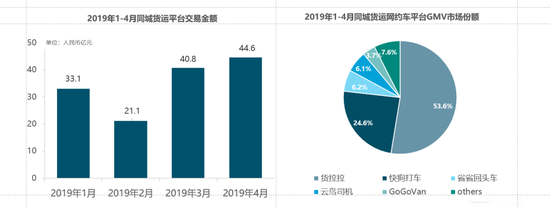 Domestic intra-city freight market share from January to April 2019
Domestic intra-city freight market share from January to April 2019Just when people thought that the competition pattern of the domestic intra-city freight industry was stable, with the entry of giant players such as Didi Freight, the war in this industry was ignited again.
In April 2020, Didi invested 100 million yuan to establish Didi Freight, officially entering the intra-city freight track. Didi, who is well versed in price wars, started the subsidy war as soon as they entered the market.
On the driver side, as long as you register for the APP, you can get a red envelope of 50 yuan, and new drivers can get a red envelope of 200 yuan. After registration, by participating in various activities, drivers can get subsidy rewards ranging from 80-300 yuan per day; on the user side, Didi Freight has also launched discounts such as “first cents” and “30% discount coupons” .
Faced with the overall situation of Didi Freight, Huo Lala took the lead in making countermeasures. On the driver side, Huolala launched a cash-swiping campaign in 2020, and also relaxed the requirements for drivers. Those who do not have a vehicle can also register and provide a vehicle; for the user side, it also launched a “1-cent delivery” Discounts such as “God Voucher” and 50% off monthly card can be said to be step by step against Didi Freight.
Although Kuaigou Taxi is weaker than Cargo Lala, in the face of Didi Freight’s offensive, it also launched a 20-yuan reward for the driver; “, “338 minus 30”, “1288 minus 100” and other discounts.
In addition to fighting the subsidy war, the wars of various families are also displayed on the stickers.
Simply put, when a driver registers with a certain platform, the platform will require the corresponding platform Logo or slogan sticker to be affixed to the operating vehicle. On the one hand, in order to prevent the driver from taking business from other platforms, on the other hand, it is also for the sake of a better brand. Spread.
In order to encourage drivers to do this, for example, Didi Freight will give drivers a OEM subsidy of 700 yuan every six months, but they will be fined 200 yuan if they are found to have torn up privately. According to Wired Travel, Huolala and Kuaigou taxis also have corresponding requirements and punishment mechanisms.
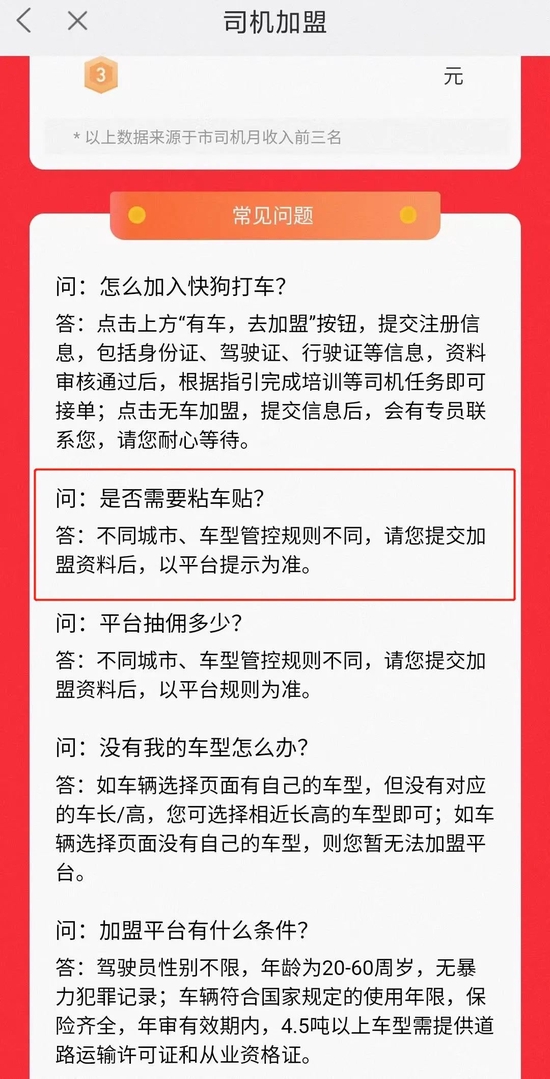 Kuaigou taxi’s requirements for car stickers, screenshot from Kuaigou taxi driver version APP
Kuaigou taxi’s requirements for car stickers, screenshot from Kuaigou taxi driver version APPFacts have proved that after more than a year of subsidy and OEM battles, the new player Didi Freight successfully defeated the old player Kuaigou Taxi and took the second place in the entire industry in 2021; while the weaker player Kuaigou Taxi can only succumb to Huo Lala and Didi Cargo, and its market share has decreased again.
Today, for Kuaigou Taxi, it not only needs to bear the dual pressure of declining market share and insolvency, but also needs to face the pursuit of new players such as Manbang Group and SF Express in the past two years. In such a predicament, Kuaigou Dache can only pin its future on the sinking market.
3
Going deep into fourth- and fifth-tier cities, can Kuaigou have a future?
It is not surprising that Kuaigou Taxi will be optimistic about the sinking market.
According to statistics from Zhiyan, the market size of the domestic intra-city freight industry has shown a trend of increasing year by year, from 710 billion yuan in 2013 to 1,273.2 billion yuan in 2019, with a compound annual growth rate of 10.22%. They also said that in the next 3-5 years, the industry is expected to maintain a growth rate of 4%-7%, and the market size will exceed 1.6 trillion yuan in 2026.
However, according to Zhang Xiang, a specially-appointed expert from China Bolian Think Tank, since 2014, although the scale of the entire industry has continued to grow, the market in first- and second-tier cities has become saturated, and the sinking market represented by third- and fourth-tier cities It has not yet been fully developed, and there is still great growth potential.
Huolala publicly stated in 2020 that as of 2018, it has basically completed its business coverage in first- and second-tier cities, and then it will penetrate into fourth- and fifth-tier cities in order to open up more sinking markets.
The voice just fell. At the end of that year, Huolala not only announced that it had completed its Series E financing worth US$515 million, but also stated that the financing will be mainly used for the expansion of the sinking market. Huolala founder and CEO Zhou Shengfu also said at that time that the expansion of the market will continue to accelerate, especially the expansion of the fourth and fifth line sinking markets.
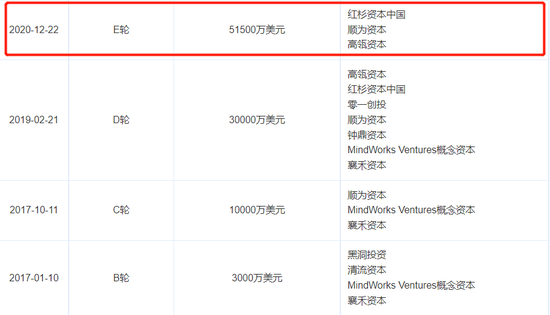 Part of the financing details of Huolala, screenshots from Aiqi
Part of the financing details of Huolala, screenshots from AiqiIn May 2021, Huolala announced that its cross-city truck business has covered 116 domestic cities, including all first- and second-tier logistics nodes, of which 23 cities have entered the third- and fourth-tier sinking markets. It is expected that the business will penetrate into 179 cities within the year, forming a network covering basic node cities across the country.
From this point of view, although Kuaigou Taxi has begun to lay out the sinking market in 2020, at the same time, Huolala is also doing the same. So in the view of the industry, even if Kuaigou Dache is currently ready to increase the weight in the sinking market, it will still be “hand-to-hand” with Huolala in the sinking market in the future. Whether it can gain an advantage is still unknown.
In addition to the challenges of other players in the industry, Kuaigou Dache will also encounter the risk of market adaptability in the sinking market.
“Different from first- and second-tier cities, although the third-, fourth-, and fifth-tier sinking markets have great development potential for intra-city freight transport, it cannot be avoided that because freight-related business generally occurs in the network of acquaintances. Waiting for the platform to deploy more sinking markets, it will take time for consumers in these markets to adapt to third-party platforms to deliver goods,” said Yang Daqing, an expert in the logistics industry, to Sina Technology.
Zhang Xiang also said that although there is a certain market for intra-city freight, it does not have a strong demand like online car-hailing. Therefore, when the business sinks, there is no guarantee that the overall demand of these markets can be fully utilized.
Regarding this risk, Kuaigou Dache also wrote in the prospectus that “with the continuous growth of the business and the continuous expansion of services, it may face challenges in realizing user satisfaction on a large scale, which may affect the ability to attract and retain users. adversely affect the business, results of operations and financial condition.”
The safety and compliance of intra-city freight will also become another major risk factor for the development of Kuaigou Taxi.
In February last year, the “crash and death of a female cargo Lala passenger” exposed the safety issues of the same-city freight platform to the spotlight. After the incident, Huolala admitted that there were problems such as lack of safety warning, imperfect product safety functions and slow follow-up, and announced the rectification work plan.
Although the platform involved is Lala, Kuaigou Taxi and other platforms have successively upgraded platform security measures, including but not limited to launching the in-vehicle recording function, and promoting intelligent driving recorders in pilot cities to avoid similar incidents. event.
Two months later, the Law Enforcement Corps of the Shanghai Municipal Commission of Transportation and other departments conducted joint interviews with online freight platforms such as Huolala and Kuaigou Taxi, requiring all online freight platforms to take offline real-world experience vehicle verification for all vehicles registered on the platform, and prohibit the provision of vehicles. Dangerous goods transportation matching business, timely provision of registration and operation data, setting up full-time safety emergency liaison officers, and timely reporting of violations or accidents.
In addition to external risks such as industry competition, differences in consumer usage and intensified regulation, Kuaigou Dache’s internal risks also affect the layout of the sinking market.
According to the prospectus, the gross profit margins of Kuaigou Taxi from 2018 to 2020 are 23%, 31.6% and 34.6% respectively, which are increasing year by year. The reason for this increase is that Kuaigou Taxi is due to its tax on domestic and overseas drivers. The commission rate is also increasing year by year, from 1.9% and 4.2% in 2018 to 8.3% and 8.1% in 2020.
Many drivers are complaining about the year-by-year increase in commissions. Faced with this situation, last year, the Ministry of Communications of China issued relevant regulations to restrict the commissioning of intra-city freight platforms. As a result, the net commission rate of Kuaigou Taxi in China was reduced to 2.6%. Restricted, its net rake rate continued to rise to 9.1%.
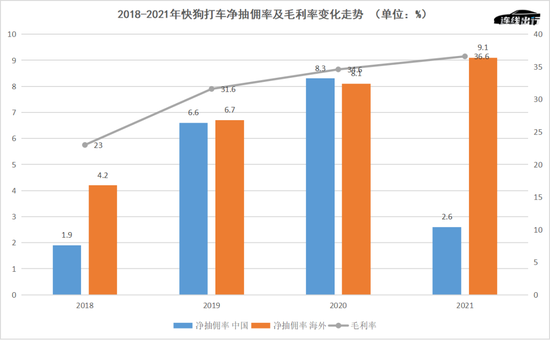 2018-2021 Kuaigou Taxi’s net commission rate and gross profit rate change trend, the data comes from the prospectus, online travel mapping
2018-2021 Kuaigou Taxi’s net commission rate and gross profit rate change trend, the data comes from the prospectus, online travel mappingAlthough domestic commissions have declined, the overall gross profit margin of Kuaigou Taxi still rose last year, reaching 36.6%, based on the continued high net commission rate overseas. However, according to Zhang Junyi, a senior expert in the field of travel, Kuaigou Dache maintains a high gross profit margin mainly to give investors confidence, but if this goal is achieved simply by increasing the commission for drivers, this may not be sustainable in itself. way of doing.
In addition to the gross profit margin problem, the difficulty of making a profit is also a big hidden danger.
In terms of risk factors in the prospectus, Kuaigou Taxi mentioned that “since its establishment, it has incurred significant losses and may not be able to achieve profitability in the short term.” At the same time, it also stated that since the intra-city logistics business is still in the early stage, the company has made a lot of investment to promote business growth, and considering the business investment plan, it is expected to continue to incur losses at least until 2024.
As a result, even if Kuaigou Dache used the money raised in this listing to pay off its debts, the subsequent losses would still not be able to support its layout in the sinking market.
Based on the above analysis, from the perspective of the industry, Kuaigou Dache is ready to further increase its weight in the sinking market, but it is not easy to really get through the sinking market and improve its current predicament.
Perhaps Kuaigou Taxi also realized this fact, and in addition to sinking the market, it also prepared Plan B.
Kuaigou Taxi has not given up its layout in first- and second-tier cities. After downloading the Kuaigou taxi user version and the driver version APP, you can see that the Kuaigou taxi user version still offers discount coupons of 10 yuan off 1 yuan and 9.5% off for new Hangzhou users. , as well as preferential activities such as “preferential packages, time-limited spikes”, “invite friends to help, and move to save 100 yuan”.
In the driver version, Kuaigou Taxi also launched the “invite friends to get cash” new incentives within Hangzhou, that is, invite an unregistered new driver to reward 200 yuan, and invite a registered driver who has not paid insurance. Reward 50 yuan.
 Kuaigou taxi driver terminal and user terminal discount and reward activities, screenshots from the Kuaigou taxi APP
Kuaigou taxi driver terminal and user terminal discount and reward activities, screenshots from the Kuaigou taxi APPIn addition, Kuaigou Taxi will be more dependent on overseas markets in the future. According to the prospectus, while Kuaigou Dache’s domestic business revenue growth has slowed in recent years, its overseas market business revenue has grown year by year, whether it is platform business, or enterprise business and value-added business. , all of which are true.
Because of this, Kuaigou Dache also stated in its prospectus that “the total amount of consignment order transactions in overseas markets has increased, mainly due to the increase in online penetration in the Asian intra-city logistics market, and the strong demand for logistics services.”
From this point of view, although it is necessary to determine whether Kuaigou Dache can help it improve its predicament with the help of overweight to sink into the market, it also depends on its subsequent performance. But what is certain is that all of this is based on the successful landing of Kuaigou Taxi on the Hong Kong Stock Exchange.
(The head image of this article comes from Kuaigou taxi official WeChat.)

(Disclaimer: This article only represents the author’s point of view and does not represent the position of Sina.com.)
This article is reproduced from: http://finance.sina.com.cn/tech/csj/2022-04-27/doc-imcwipii6764490.shtml
This site is for inclusion only, and the copyright belongs to the original author.